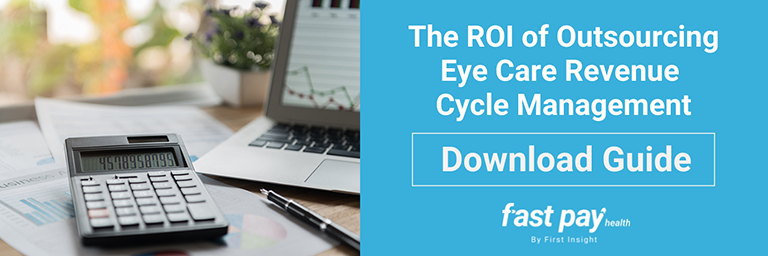
01 Feb 10 Benefits to Outsourcing Optometric Billing & RCM
Is your ophthalmology and optometry practice getting your money’s worth with your in-house billers or optometric billing service? Choosing the right billing and revenue cycle management (RCM) service is more than finding someone to process and post claims.
If you are considering outsourcing your insurance and vision plan billing and other RCM tasks, here are ten benefits to help you decide.
1. Reduce the Accounts Receivable Cycle with Smarter Billing
Does your eye care practice have unhealthy cash flow and out-of-control accounts receivable (AR)? Ever wonder where your revenue is hiding? If claims aren’t being filed, your claims are rejected or denied, or payments aren’t being posted, your AR reports will not be accurate.
Researching a single unpaid claim might take five minutes, but frequently it takes an hour. Does anyone at your office have an hour or three to spare on a busy Monday? Probably not.
An optometry billing service like Fast Pay Health by First Insight focuses on AR cleanup. They review outstanding balances and analyze unpaid claims, then carry out an action plan to recover the amount due, verify receipt of claims, and enter everything into your practice management system. Payments are typically received within 2–3 weeks versus 60–90 days, and remits are posted daily.
Related: How to Reduce the Accounts Receivable Cycle with Smarter Billing
2. Ensure Accurate Patient Eligibility & Benefits Verification
Verifying eligibility and benefits before submitting an insurance claim to a clearinghouse, vision plan, or insurance payer is crucial to maintaining healthy revenue. If you ignore patient eligibility and verification up front, you risk unhealthy revenue problems.
Eligibility verification ensures the insurance data is correct and helps determine the amount a patient may owe (e.g., co-pays, co-insurance, and deductibles). Providing patients with more accurate cost estimates can significantly boost patient satisfaction and save you from future claim denials.
Related: Reduce Denied Claims with Proactive Insurance Eligibility Verification
3. Maximize Reimbursements with Correct Billing Modifiers
It’s not uncommon for optometry and ophthalmology practices to frequently misuse medical billing modifiers. Did you know you might be expected to return money that insurance or third-party payers paid you if you used a modifier incorrectly?
When you use a medical billing modifier on a claim incorrectly, this can become a costly mistake. Optometric billers know when and when not to use a modifier to maximize reimbursement and prevent claim denials and potential audits.
Related: How (and How Not) to Use Common Medical Billing Modifiers
Related: Preparing for a Vision Plan and Medical Insurance Billing Audit
4. Keep Your Staff Up-to-Date with Medical Billing Rules and Code Changes
Keeping up with confusing and never-ending optometry and ophthalmology medical billing rules, CPT® and ICD-10 code changes, insurance payer and managed vision plan requirements, and complicated electronic data interchange (EDI) processes is time-consuming and frustrating. Fast Pay Health optometric billers and coders have extensive experience in medical billing and RCM processes.
In addition, to ensure you are coding your eye care claims correctly, you must also remain diligent with Local Coverage Determinations (LCD), National Coverage Determinations (NCD), and Medicare Administrative Contractors (MAC) in your area and sign up to receive payer listserv updates.
Related: Eye Care Related 2023 CPT® Code Changes
Related: Vision Plans vs. Medical Insurance: When Should You Bill?
5. Uncomplicate the Provider Credentialing Process
Suppose the provider isn’t properly credentialed or re-credentialed with the insurance company and enrolled by insurance payers and the Council for Affordable Quality Healthcare (CAQH®). In that case, the insurance payer will not reimburse the provider for services rendered.
To complicate things further, you must regularly follow up with insurance payers to ensure the providers are enrolled in-network when enrollment is open. On average, the provider credentialing process can take 60 to 120 days, so planning is crucial.
Related: Critical Steps for Efficient Provider Credentialing and Enrollment
6. Eliminate the PHI Privacy and Data Security Worry Factor
Ensure the privacy and safety of data with HIPAA-compliant billing services. Eliminate the Protected Health Information (PHI) worry factor.
Fast Pay Health takes PHI security and privacy seriously. We train and monitor our billing consultants continuously to ensure they comply with current PHI and HIPAA rules. To minimize security risks, we use your practice management system to prepare and transmit claims, post payments and run necessary reports.
7. Reduce Insurance Reimbursement Delays with Constant Claim Scrubbing
Ensure your eye care practice management system includes features supporting claim scrubbing edits that alert you to a missing referring or ordering physician.
Why? You don’t want your claims sent to insurance companies with errors, causing rejections and costly delays in reimbursement. Fast Pay Health billers are experts at ensuring your claims are clean and free from errors before they submit them.
Related: 12 Optometry Billing Tips to Improve Collections
8. Decrease Insurance Claim Rejections and Denial Follow-ups
If you notice more claim rejections and denials, it’s critical to focus on cash flow to stay in business. Your staff doesn’t have the time to wait around listening to insurance companies’ on-hold music or Interactive Voice Response (IVR) systems when they could be spending their time on more important things.
Once an eye care practice receives a claim denial, reworking and resubmitting the claim can delay cash flow by 45 to 60 days. Researching and resubmitting denied claims can lead to long, frustrating hours trying to figure out what claim denial and adjustment reason codes mean and what action to take.
Costs incurred for re-submitting a claim add hours to your staff time and wages you can’t get back. A worst-case scenario is that if you don’t re-submit the claim to the insurance payer within the permitted time frame, it will probably get rejected again.
Related: 6 Eye Care Claim Rejections You Can Overcome
Related: Mastering Claim Denial Reason Codes Expedites Cash Flow
9. Delegate Researching (and Resubmitting) Aging Claims
Do you review your aging claims daily to see why open balances are still outstanding? Fast Pay Health does. It’s critical to pay close attention to claim rejections on the clearinghouse reports and claim denials on the remits.
Aging claims happen, but you can decrease them when you have a stronger optometry billing process—and an extension of your team to help you see that process through.
You can also run into filing claim denials if your patients have secondary insurance. Many payers require you to bill secondary insurance within 180 days or less after you receive the primary payment.
10. Get Multiple Billers for the Price of One
Get peace of mind with “uninterrupted” daily service during business hours. Never worry about delayed payments, planning for staff vacations, unplanned sick days, turnover, or costly re-training. Overall your staff will save time since they won’t spend so much on repetitive billing tasks. Think of your optometric billing service as a dependable extension of your practice.
At Fast Pay Health, your dedicated biller submits claims, posts insurance payments, and researches unpaid AR—all for the price of one biller.
Focus on your patients and other important parts of your practice. Eliminate spending hours on the phone with insurance companies. More Patients = More Revenue.
Are You Ready to Get Paid Faster?
Outsourcing optometry and ophthalmology billing services allow you to delegate the above tasks to a professional team specializing in the nuances of the financial twists and turns related to eye care. This improved process ultimately saves you time and money.
Get started today with a free practice analysis from Fast Pay Health by First Insight. We get paid when you get paid, and there is no monthly minimum and no setup fees. We work with ANY optometry and ophthalmology practice management software.






